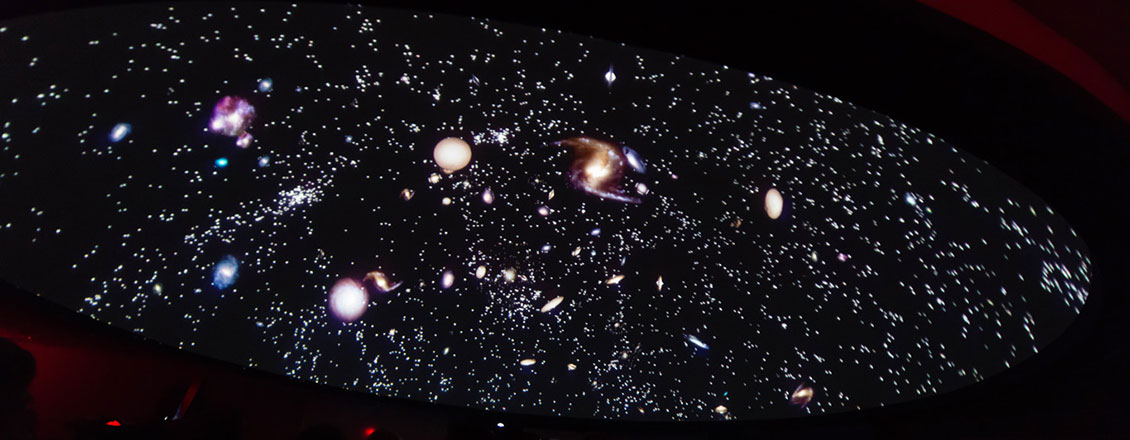Our digital films showcase imagery from NASA, engaging animation, and scientific content.
We are proud to present the Digistar 7 projection system, made possible by a grant
from The Dale and Frances M. Hughes Foundation.
Both the museum and planetarium are included in a single admission fee.
Films are 25-35 minutes long.
Films are appropriate for all ages.
Most films include sections with dynamic visuals and increased volume. If anyone in
your group is sensitive, please contact us about low sensory input or alternative
visit options.
Groups:
Planetarium Films
Big (25 minutes) 10:30 a.m. - may vary during group visits
BIG tackles this question by taking the audience on an immersive journey to the farthest
reaches of the universe that we are able to observe. BIG combines a light-hearted storytelling style with computer animation, stop-motion
character animation, and a surround-sound musical score to bring a really big subject
down to Earth.
The Little Star that Could (35 minutes) 11:30 a.m. - may vary during group visits
Discover our solar system through a new set of eyes that blends scientific simulations
with kid-friendly characters. Little Star, an average yellow star, wants planets to
protect and warm. He is guided along his way by other stars, learning what makes each
star special, and discovering that stars combine to form clusters and galaxies. Eventually,
Little Star finds his own planets. Fly along with Little Star as he learns about the
universe, gets up close and personal with stars of all kinds, and gains a new appreciation
of himself as our own special Sun. Ideal for ages Pre-K to second grade.
Experience the Aurora (27 minutes) 12:30 p.m.
Groundbreaking high-resolution photography reveals the science behind a celestial
phenomenon. Over seven months in the Arctic Circle, film crews captured timelapse
images of the Aurora Borealis—also known as the Northern Lights—with high resolution
digital cameras. The results are spectacular. For the first time, the aurora has been
captured as it was meant to be experienced, as a display that covers the entire sky.
This immersive show shares the science behind the lights while explaining the challenges
of tracking and capturing the aurora.
Astronaut (23 minutes) 1:30 p.m.
Ewan McGregor shares the astronaut-eye view of how space travel affects the human
body. The exploration of space is the greatest endeavor that humankind has ever undertaken.
What does it take to be part of this incredible journey? What does it take to become
an astronaut? Experience a rocket launch from inside the body of our test astronaut,
Chad, as we subject him to everything that space has to throw at him. Explore the
amazing worlds of inner and outer space, from floating around the International Space
Station to maneuvering through microscopic regions of the human body.
Stars (26 minutes) 2:30 p.m.
What are we made of? Where did it all come from? Explore the secrets of our cosmic
chemistry and our explosive origins. Every star has a story. Some are as old as time,
faint and almost forgotten. The legendary Mark Hamill explores the awesome beauty
and destructive power of stars. Stars focuses on the lives of the stars, how they are born, how they die, and how human
understanding of the stars has changed over time. From Native Americans to Newton,
from the electromagnetic spectrum to Einstein, audiences explore nebulae, star clusters,
pulsars, black holes, and more.
Violent Universe (25 minutes) 3:30 p.m.
The beauty of a starlit sky conceals the violent forces at work within our universe.
Witness the forces that hold the universe together—and occasionally try to rip it
apart. None other than Sir Patrick Stewart explores the mysterious forces at work
in the universe around us. Comets, asteroids, and meteors hurtling through space.
Stars collapsing under their own gravity. Infernos of nuclear energy releasing their
deadly radiation across the universe. Witness the raw power of the cosmos in this
thrilling show that gives you a front-row seat as worlds collide!




